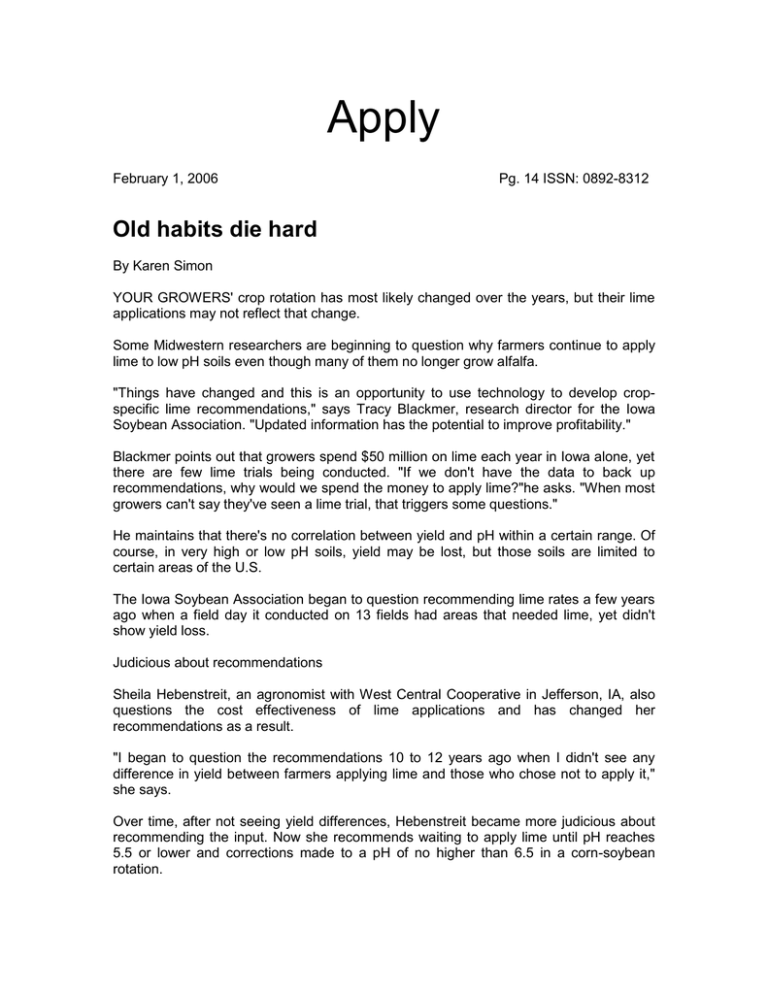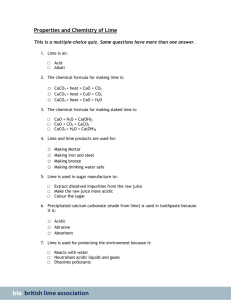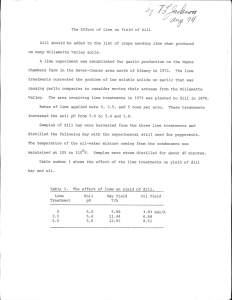Apply Old habits die hard
advertisement

Apply February 1, 2006 Pg. 14 ISSN: 0892-8312 Old habits die hard By Karen Simon YOUR GROWERS' crop rotation has most likely changed over the years, but their lime applications may not reflect that change. Some Midwestern researchers are beginning to question why farmers continue to apply lime to low pH soils even though many of them no longer grow alfalfa. "Things have changed and this is an opportunity to use technology to develop cropspecific lime recommendations," says Tracy Blackmer, research director for the Iowa Soybean Association. "Updated information has the potential to improve profitability." Blackmer points out that growers spend $50 million on lime each year in Iowa alone, yet there are few lime trials being conducted. "If we don't have the data to back up recommendations, why would we spend the money to apply lime?"he asks. "When most growers can't say they've seen a lime trial, that triggers some questions." He maintains that there's no correlation between yield and pH within a certain range. Of course, in very high or low pH soils, yield may be lost, but those soils are limited to certain areas of the U.S. The Iowa Soybean Association began to question recommending lime rates a few years ago when a field day it conducted on 13 fields had areas that needed lime, yet didn't show yield loss. Judicious about recommendations Sheila Hebenstreit, an agronomist with West Central Cooperative in Jefferson, IA, also questions the cost effectiveness of lime applications and has changed her recommendations as a result. "I began to question the recommendations 10 to 12 years ago when I didn't see any difference in yield between farmers applying lime and those who chose not to apply it," she says. Over time, after not seeing yield differences, Hebenstreit became more judicious about recommending the input. Now she recommends waiting to apply lime until pH reaches 5.5 or lower and corrections made to a pH of no higher than 6.5 in a corn-soybean rotation. The soils in her area are from the Des Moines lobe. She says it's more difficult to see a response from lime on these soils. At the same time, the chances of negative response from lime applied in areas that don't need it (soils high in free calcium) are much greater. Hebenstreit says lime application significantly impacts the cost of production. Input costs can run $50/acre. Even when spread over five years, $10/acre/year is still a significant input cost, she says. "We need to determine whether or not there is a place for lime in our soils or if it's something we can leave out and put that money on the profit side instead of the expense side," she says, noting that she has closely followed the work of Fred Blackmer, an Iowa State University agronomist and soil fertility researcher. He has been working to determine the responsiveness of lime on Clarion-Nicollet-Webster soils. "As an agronomist, I'm trying to help farmers make the most economical decisions, even when it may mean reduced product sales," Hebenstreit says. She is anxious for some hard data to show growers. "It's tough to change any long-term practice until you see the research and see how it's working on other farms," she says. "It will take research to convince most growers this might not be a necessary input. But as times get tougher, the issue might get challenged more quickly." Grower field study Some growers, like Craig and Paul Heineman of Ogden, IA, conduct their own on-farm trials. The Heinemans have conducted a lime study for four years and had two years of data on the field before they began the on-farm trials. The trial included two strips that corrected pH to 6.5 and 6.9 with a check strip, which were replicated for a total of two sets of three strips. The field consists mostly of Clarion Nicollet soils and fairly consistently tested at pH in the lower 5s. "I really thought when we started that if there was a benefit to lime, it would be in this field," says Craig Heineman. However, according to his data over four years, applying lime didn't pay, even though there was a yield increase (see chart below). "We'll continue the test, but this raises a lot of questions," Heineman says. "I would like to see more tests; it's hard to draw conclusions from one location and one test. Multiple years and locations make for better information." Heineman says he no longer applies lime to his other fields. "Truthfully, it bothers me not to apply lime, but so far what we've seen is that it doesn't seem to pay for us," he says. "Our goal is to use our money efficiently and we don't want to throw money out there just because we've always done things a certain way." As much as Heineman questions the data from his on-farm trials, the findings are supported by research conducted at Iowa State University by Antonio Mallarino and graduate research assistant Agustin Bianchini. In the study published in a 2002 issue of the Agronomy Journal, the average yield response to lime was .6 bu./acre, so it wasn't economically feasible to apply lime in that case either. Factors to consider The practice of altering soil pH by applying lime is firmly entrenched and widely misunderstood, says Tracy Blackmer of the Iowa Soybean Association. "Because a pH of 7 is considered neutral, many farmers consider this to be their target for maximizing yield. But that's a myth that's not supported by data; it's agronomically indefensible," he says. "We need to know what's optimal and then determine if we need to shift the pH to meet that optimal target." Blackmer says there are a lot of questions when it comes to lime. For example, he says no one really knows what the pH needs to be for each crop because there is no recent data based on a corn-soybean rotation. Another argument for applying lime is that it increases the effectiveness of herbicides. Blackmer maintains that in many cases the technology has changed so herbicides are not as greatly affected by the use of lime. "Plus it's an expensive way to maintain the effectiveness of inputs," he adds. So why not simply study lime and the impact of pH on corn and soybean yields? There are some field trials taking place, but there are challenges. Finding fields low in pH is difficult. Lime takes awhile to affect the soil, and each soil type reacts differently. Another piece of the equation is the depth of soil samples and the availability of lime. Most soil samples are taken at 6 to 12 in., but most roots grow much deeper. So what's the soil like at the depth the roots are growing and what are the needs of the soil at that depth? While there are a lot of factors to consider, Blackmer urges growers to ask questions before applying lime. He recommends making applications in strips to compare results at the end of the season. He emphasizes that soil pH might go up and yields might even increase, but does it pay? Lime in corn-soybean rotation Others have found that in many cases, lime does not pay. Gyles Randall, a soil scientist at the University of Minnesota, says he's not a lime expert, but he's been conducting field research because he has done work identifying highly acidic soils. Randall says a lot has changed in the 30 years since lime recommendations were developed, when alfalfa was a primary crop and lime was a cheap input. Now, he says, few farmers in Minnesota grow alfalfa and lime is expensive. "We found that alfalfa does respond to lime, in the first year particularly," he says. "When we looked at a corn-soybean rotation, we couldn't get lime to pay when amortized over 10 years. We were getting a slight increase in yields, but not enough to pay for the product." In the Minnesota trials, Randall saw an increase of 5 to 8 bu./acre for corn and 1 to 2 bu./acre for soybeans. He stresses that a key factor to consider is soil type. His studies were conducted on Nicollet soils with an average surface pH of 5.3, but below 24 in., pH ranged from 7.0 to 8.2. He will wrap up his study after this year's growing season, but for current results, visit http://sroc.coafes.umn.edu, select soil/water quality, then go to the 2005 research results. "Some have marketed lime application very aggressively, but look at the costs," he urges. This story first appeared in the February issue of The Corn and Soybean Digest and was adapted for APPLY.







